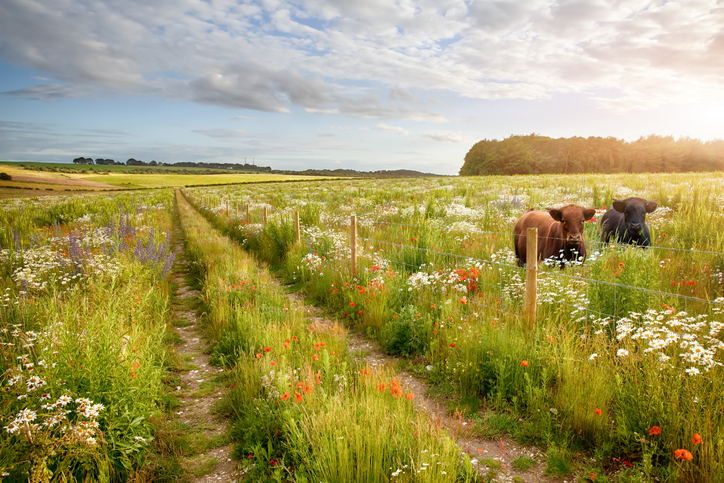
The new Environment Bill has finally become law this year. What impact can we expect it to have on farms, estates and rural businesses?
After a tortuous five-year journey through Parliament (during which its progress was repeatedly set back by general elections, changes in government, Brexit and Coronavirus), the Environment Bill has now finally become law as the Environment Act 2021.
The new Act of Parliament is likely to have significant and wide-ranging consequences across a range of sectors. This article looks at what the potential impacts are likely to be for farms, estates and other rural businesses.
Impact of the Environment Bill on developments
Mandatory biodiversity net gain
The requirement that all new development should provide a 10% net gain in biodiversity is probably the most significant “concrete” change for the rural sector, and is likely to offer both challenges and potential opportunities.
Firstly, if you are planning to develop your property in a way which will require planning permission, then you will need to demonstrate how you will secure the 10% net gain in biodiversity.
Small developments
If your project is small (constructing a new holiday cottage, for example, or replacing a substantial agricultural building) this might just be a case of installing some bird boxes and creating new green spaces nearby. However, you will need to factor in the cost of both the work itself and of obtaining a report from a suitable professional to satisfy the planning authority that the biodiversity measures are sufficient.
Larger developments
Larger projects are likely to require more biodiversity enhancements, which might include permanently dedicating areas to nature.
If you are selling land for residential or commercial development then that possibility may be a significant issue, since the developer might need to set aside parts of the site for biodiversity enhancements like parks, wildflower meadows or orchards. That will reduce the number of houses or commercial units which can be built, which may lead to developers offering a lower price for your land.
Opportunities created by Environment Bill
The need to dedicate land for biodiversity enhancement does present an opportunity.
Although on-site biodiversity enhancement is preferred, developers will in many circumstances also need to “offset” their development’s impact by supporting biodiversity enhancements nearby.
Local landowners who are already managing their land for wildlife (or considering converting unproductive agricultural land) may therefore be able to secure funding for both capital works and ongoing maintenance and management costs in exchange for dedicating land to nature for an extended period.
The Act also provides for developers to be able to buy “credits” from DEFRA to satisfy the need for biodiversity net gain – the proceeds would then be re-invested by DEFRA into suitable wildlife projects. This option seems most likely to be of interest to landowners (or collectives of landowners) with substantial projects in mind, such as extensive re-wilding.
Conservation covenants
The Act allows for landowners to give “conservation covenants” to local councils, some charities (such as the National Trust and county wildlife trusts) and statutory bodies like the Environment Agency and Natural England.
These covenants are legally-binding promises that the landowner and future owners will manage some or all of their land in a certain way, such as in accordance with an agreed management plan. The intention is to ensure that investments in nature, wildlife and biodiversity enhancements are secured for an extended period, preventing the land being developed or immediately converted back to intensive cultivation.
Conservation covenants are reasonably flexible tools, but their most obvious potential use is to protect the off-site biodiversity enhancements mentioned in the previous section. Local planning authorities and developers will need to ensure that the enhancements they pay for are maintained for the long term and a conservation covenant provides the perfect mechanism.
We may also see conservation covenants used to protect capital investments made by DEFRA through Environmental Stewardship and other agri-environment schemes.
Water abstraction licences
Abstraction licences allow licence holders to abstract certain volumes of water from rivers, lakes and groundwater.
The Environment Act introduces new powers allowing the Environment Agency to vary abstraction licences without paying compensation when:
- The proposed variation (including outright cancellation of the licence) is necessary to protect the environment; or
- The licence holder has routinely abstracted much less than allowed by their licence (defined as less than 75% of the maximum volume in each of the preceding 12 years).
These powers come into effect on 1 January 2028. You can read more about water abstraction licences in this article.
Targets and principles in the Environment Bill
The new Environment Act requires DEFRA to set legally-binding environmental targets in several key areas. It also obliges all government departments to take environmental principles and considerations into account when drafting legislation and setting policy.
Given how important environmental matters have become to the general public, these commitments might be just a formalisation of what is already taking place in practice. However, they do confirm that environmental considerations are here to stay, and are likely to be given very significant weight when the government comes to consider matters of crucial importance to the rural economy, such as agricultural subsidies.
If you would like to discuss the impact of these changes on your business, please get in touch.
